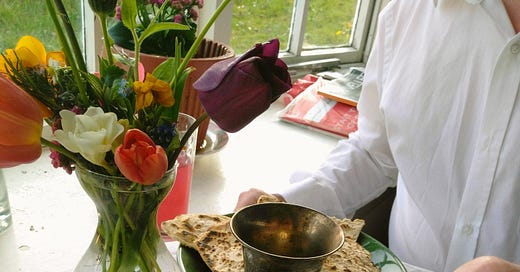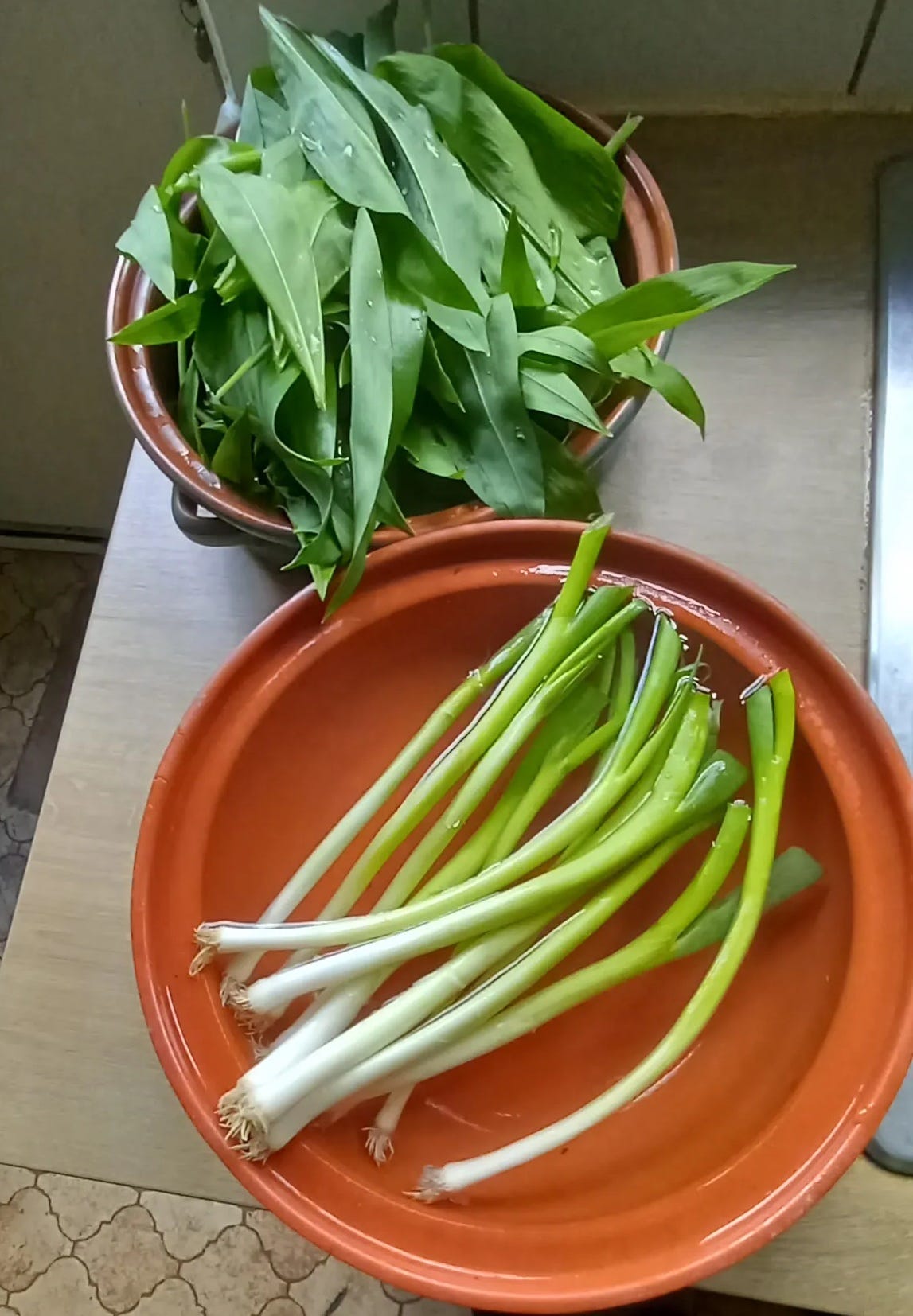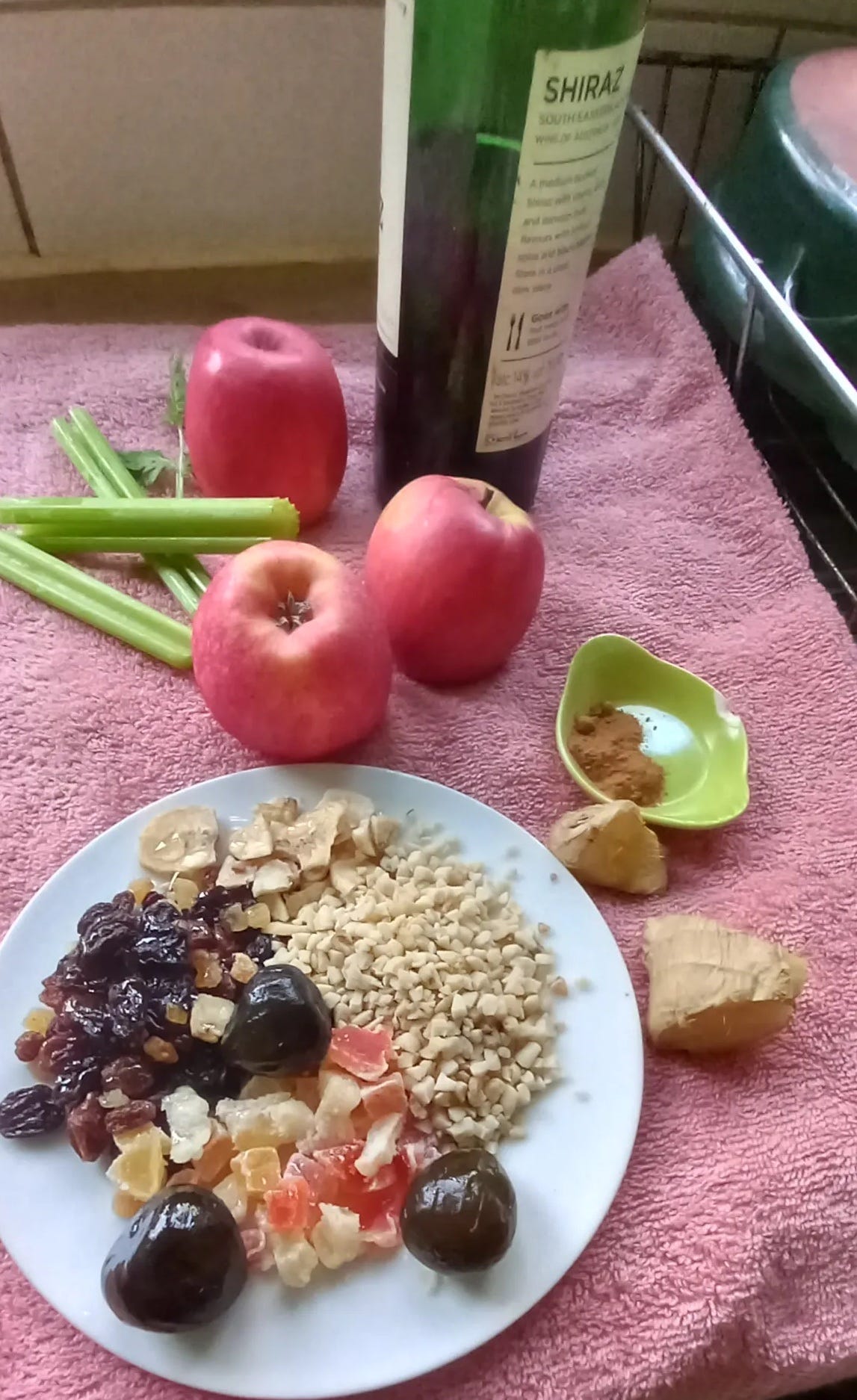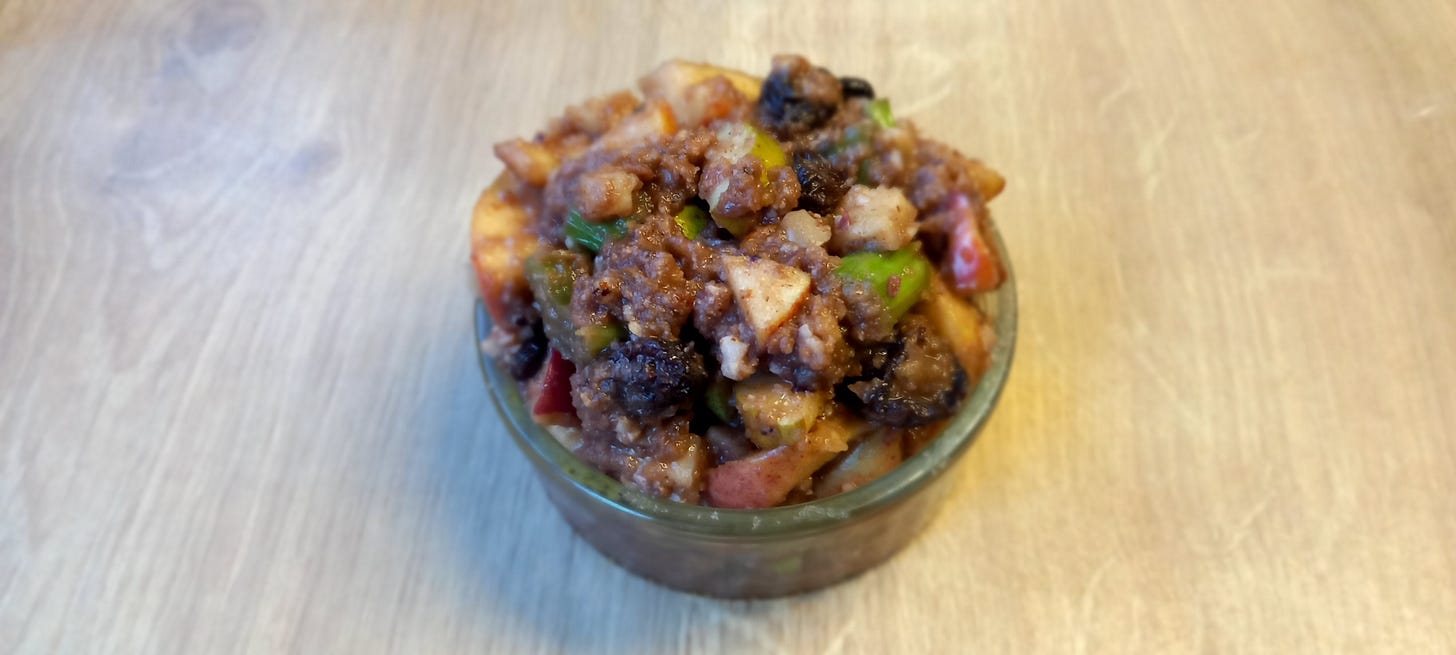Happy Pesach—in English, Passover— for you who observe and celebrate, and for you who may not celebrate but have had the good fortune to get invited to a Seder and enter into the spirit.
Dipping the parsley, into the salt water, with the seder plate: haroset, bitter herbs (in this case, horseradish), homemade matzot, Kiddush cup for wine…flowers, because: its Springtime!
But first let me explain: Pesach lasts 8 days (7 in Israel); during this time nothing levened is allowed: no bread, no pasta, no crackers, no dumplings; certain groups abstain from beans, legumes, corn and rice too. Others don’t.
The holiday is ushered in the first night with a ritual meal, The Seder. Often a large gathering, sometimes only for one or two; I have found that it doesn’t matter. You can find meaning in a Seder of any size. And because having a seder is such an unusual evening, and also you’ll probably have leftovers, the second night: there is a Seder as well, albeit a little bit streamlined perhaps. Many go to family one night, and the other to a community or friends Seder.
Joining the Pesach table is more than sitting down to a meal: it is entering into an event, recounted by narration, that takes us from slaves in Egypt, to a cohesive people in the “Promised Land”. Did we all get along on the shlep from Egypt to Canaan? No (“I want to go back to Egypt, I miss the garlic and leeks!” Did we argue? Oy, did we argue! (“This cow is made all of gold, and frankly it looks like an excellent thing to worship, being as how you can actually see it”).
So if there is arguing or kvetching at the Seder, don’t worry. How could it be otherwise? (If you grew up at a Jewish family table, you’ll understand immediately.). It seems its always been thus, going all the way back to Moses and the wandering Israelites. Borrowing an exclamation from Tevye (and Sholem Aleichem): Tradition!
Tradition, in the form of the ritual meal and its accompanying texts, songs, stories, and stories, is the essence of the holiday itself: taking place between the pages of the haggadah, the booklet that narrates the experience of slavery and fleeing from it, the triumph of miracles over hopelessness. The haggadah story-telling, prayers, re-enactments, interactive readings, chants and songs, pulls us into the ritual meal, and in the process, can (and should) make the story, and our history, come alive. Again. As it does every year. Tradition!
For over a thousand years, the Hebrew text has remained the same, the ritual foods like matzo, moror and haroset the same as well (basically: the world of Jews is filled with more haroset flavours imaginable; I like to include one or two new ones each year to sit at our table next to this year’s reiteration of our Ashkenazi horoset.
So, the Haggadah like the skeleton to which communities, cultures and families develop their own traditions, tells the part of the story that means the most to them of their people and heritage. All bring their own story and heritage to the basic one (we are all one people).
The ritual meal has a very specific order, before you get to the actual meal. There is the wine—4 cups— (and its blessings), the matzot (and the blessing), the candle-lighting before the meal (and its blessing), there are so many blessings, all made into a juicy little sandwich between the covers of the bigger story.
Order is the important word to describe the evening: the word “seder” in fact, is Hebrew for “order”. Reading the Haggadah is like following a script in which we all take our places, and are transported to the event over a thousand years ago, as if we are reliving it, feeling its intensity as if we were watching a gripping movie in a dark theatre.
A good Haggadah is crucial. A lame haggadah makes a boring seder. (Unless thats your own family’s tradition, and while I am being a little bit provocative and silly here, you might just know what I mean). Once upon a time all families used Haggadot from a Judaica shop, or even more likely, one from the Kosher food companies who gave them out for free. Now, with the internet at our finger tips its easy-ish and satisfying (very) to write our own, placing in it all of the themes of our own time and place, honouring those of our time in other places.
The food acts like a prompt: an experience of tastes (of foods we only eat (or eat this way) at Pesach, that help transport all who are gathered.
In fact, there is a plate with the 6 main ingredients of the Seder: a place for the bitter herbs (bitter, as was the life they lead in bondage), the salt water (symbolizing the tears of the Israelite slaves). There is a hard boiled or roasted egg, for the fullness of life, the rebirth of Springtime (or of a free people) (or a people, land, family, individual, after a catastrophe). Horoset. Roasted lamb-bone to commemorate the angel of death passing over the Jewish homes in the wave of plagues (vegetarians use a beet instead).
On the plate or table is matzo—the unleavened bread the fleeing newly ex-slaves made by baking quick dough on hot rocks in the desert (no time to let it rise, hence unleavened bread). According to the rabbis, the total amount of time that Pesach matzo must take is (no more than) 18 minutes start to finish. This is the amount of time that prevents fermentation happening and levain forming, so our matzot will be as the fleeing Israelites was. [Some Jews don’t use a seder plate at all—Tunisian and Yemenite for instance—they display the various ritual foods on the table, or in reed baskets (a nod to Moses’ sister Miriam finding the reed basket in the shallow waters of the Nile, with baby Moses in it, and bringing it back to Pharoah’s daughter. This saved Moses’ life, as there was a decree of death put on Jewish male babies at this time.
I find the holiday so immensely moving, and one of the reasons is that its able to be personalized. It is a universal theme; it addresses our humanity. To me, as each group of far-flung Jews has gathered rituals and traditions from their diaspora lives, by bringing it into my own observations and traditions, it makes our history and heritage become whole again. Pesach is a holiday in which Jews from all over the world, bring their own traditions to the table. To me it says: we are all different, and yet we are all one.
And so, each time I discover a new tradition at someone else’s table, I borrow. Freely.
[Spring onions/green onions; I didn’t have enough, so ran out to the forest behind my house and foraged wild garlic (in the upper bowl.] Wild garlic may now become our own tradition! ]
My daughter and I discovered the traditions of Jews from Iran and Afghanistan when my brother married into a Jewish Iranian family. The first year that we had seder there, was lovely of course. We expected it would be.
And then, when we started singing “Dayenu”, the song of thankfullness and appreciation (Dayenu meaning: even this one little thing would have been enough for us, but…then: another miracle!), each member of the large extended family pulled out a handful of green onions and started beating each other with them. Soon they were up, chasing each other around the room, smacking here, smacking there, smacking everyone in sight as we all sang Dayenu.
My daughter and I were stunned. There was no internet in those days to tell us what was going on. My new sister-in-law told me, slightly agog that we didn’t do this ourselves in our own (suburban, California) family. “Smacking each other with green onions reminds us of relentless whipping of the Pharoah’s soldiers against the enslaved Jews.”. Plus, I must say: the room smells AMAZING, so oniony, after the green onion-slap-fest.
One dish that is part of the seder regardless of what your own traditions are, is haroset (or charoset, or charosses depending on transliteration as well as your own community), known by other names in the Mizrachi and Sephardic world), though each community makes its own, featuring the ingredients of their own diaspora world.
The relish—sometimes chunky, sometimes more of a paste, of fruit, nuts, often spices, symbolizes the mortar which the enslaved Jews used to build and hold together the bricks in ancient Egypt. The word haroset is related to the Hebrew word “cheres”, meaning clay. (Jews in Gibralter, the British territory at the tip of the Iberian Peninsula adds a pinch of real brick dust to theirs).
In Ashkenazi tradition, it is made from crushed nuts, chopped apples (or pears) and sweet red wine, while Sephardi Jews use figs or dates; but basically any combination of fresh and/or dried fruit form the basics. In her Substack newsletter (link below), Nancy Harmon Jenkins offers a blueberry, deeply darkly blue-purple and I would have made it myself this year if I had been able to find fresh blueberries. Nancy lives in Maine, where blueberries are a local treasure. Nancy got her recipe from her friend, Judy Stein; how I love how we pass around our recipes and they in turn become someone else’s tradition as well.
While most haroset include nuts, especially walnuts, I’m not sure that it is required. Looking into it, all I could find was that in the “Song of Songs”, 6:11, it says: “I went down to the garden of nuts”, which seems like good advice, or at least a lovely image.
The haroset I grew up with was your basic Ashkenazi mix of: chopped apples, walnuts, sweet wine, and cinnamon. I guess. But why did I think it had celery? I have this feeling that my grandmother added celery, so of course that is what I do: the crunchy, slightly saline sensation of celery adds to the sweetness of the relish. But am I imagining the celery?). I could ask the last of that generation in my family, but I don’t trust her answer. Even now. So regardless of whether it is a family tradition, it is now my own tradition, and making Ashkenazi haroset with celery has become my thing. I urge you to give it a try.
Here is a photo of the ingredients to my Ashkenazi haroset. I always think of it as classic, but looking at this photo, I can see that it is far from Orthodox, if you’ll excuse the pun. Along the way of my Pesach seder life, I’ve embraced a hit of ginger (from Yemeni Jews), dried candied fruit from India, and other parts east—pineapple, figs, papaya; I usually like dried cherries or cranberries too—just lovely! And as for the sweet wine, I’ve switched over to a dry red—or dry red grape juice if you prefer—and sweeten it up a bit more generously with sugar or honey. I’m not sure exactly why, but as making recipes and dishes one’s own, one year I had no sweet wine and used dry. I liked it better, and it became my go-to recipe from then on.
One year I had no nuts or dried fruit, so used Trader Joes trail mix (it was fabulous, as was their Omega-3 nut and fruit mix). Another year, even more unorthdox, my best friend tasted her finished haroset, found it lacking, so whirled into the mix a big handful of dark chocolate chips. It was delish.
Haroset
4 tasty crisp apples, unpeeled but core removed then coarsely chopped (or 3 apples, one pear)
Squeeze of lemon juice
1-2 sticks celery, chopped or diced
1 cup coarsely chopped toasted nuts (such as walnuts, hazelnuts, or a mixture of whatever you like)
1/4 cup raisins, black or golden
1/4-1/2 cup candied mixed fruits: cherries, cranberries, blueberries, apricots, tropical such as pineapple, papaya, banana (lightly crushed)
1/2 cup dry red wine or grape juice
1/2-1 teaspoon ground cinnamon
Several pinches dried ginger or 1/2 teaspoon chopped fresh
2 tablespoons or more sugar or honey—exact amount will depend on how sweet your apples, dried fruit, or wine/juice. Don’t be afraid to add more; you want it sweet and classic recipes called for either sweet wine (Ashkenazi) or date syrup (Sephardi), both of which have quite a hit of sugar-sweet.
Directions:
Combine everything, and taste for seasoning.
My own personal favourite trick is to puree half of the mixture then combine it with the unpureed part, the chunky chopped part. Taste and make sure it has enough sugar or honey—it depends a lot on the sweetness of the apples/pears, and the dried fruit, both. So measuring is not enough—you must taste!
Note: haroset, having quite a bit of liquid in the fruit and wine, becomes more watery the longer it sits (it also becomes even more delicious). If you are going to be keeping the haroset for longer than a few hours (and you are, trust me) or if you have leftovers, add a little bit of crumbled up matzo to absorb the excess liquid as it sits.









Lovely writing, Marlena! I too put up a haroset last Friday--a Maine blueberry haroset from my friend Judy Stein. I love this tradition and intend to add it to our Easter feast which this year will feature a large roasted salmon for all the pescovegetarians in the family. Happy Pesach, e Buona Pasqua Ebrea!
Dear Marlena,
thank you for this informative post. In my ashkenazi family we never celebrated Passover, I don't know why.
Happy Passover,
love,
Paule